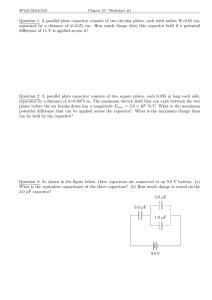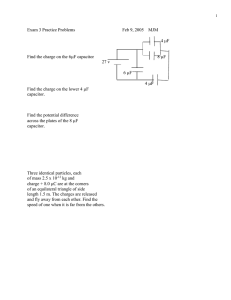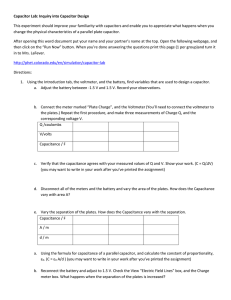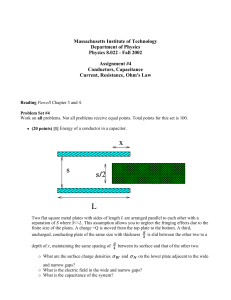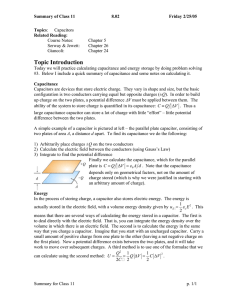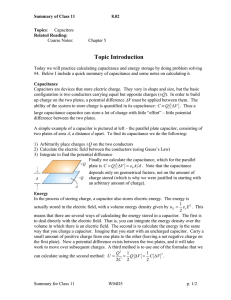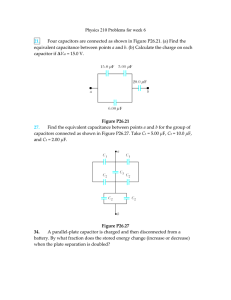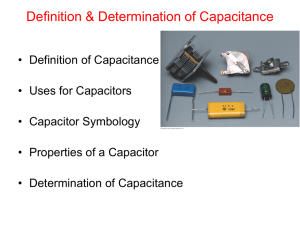A Form PHYSICS 1B QUIZ #2 FALL QUARTER 2009
advertisement
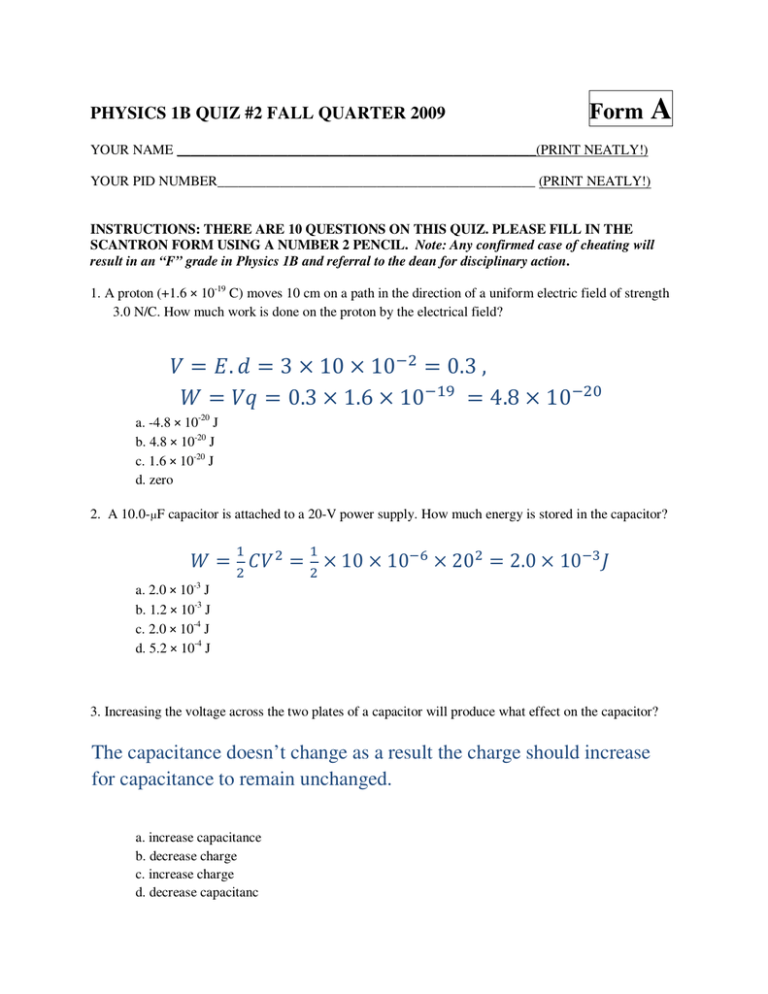
PHYSICS 1B QUIZ #2 FALL QUARTER 2009 Form A YOUR NAME ____________________________________________________(PRINT NEATLY!) YOUR PID NUMBER______________________________________________ (PRINT NEATLY!) INSTRUCTIONS: THERE ARE 10 QUESTIONS ON THIS QUIZ. PLEASE FILL IN THE SCANTRON FORM USING A NUMBER 2 PENCIL. Note: Any confirmed case of cheating will result in an “F” grade in Physics 1B and referral to the dean for disciplinary action. 1. A proton (+1.6 × 10-19 C) moves 10 cm on a path in the direction of a uniform electric field of strength 3.0 N/C. How much work is done on the proton by the electrical field? = . = 3 × 10 × 10 = 0.3 , = = 0.3 × 1.6 × 10 = 4.8 × 10 a. -4.8 × 10-20 J b. 4.8 × 10-20 J c. 1.6 × 10-20 J d. zero 2. A 10.0-µF capacitor is attached to a 20-V power supply. How much energy is stored in the capacitor? = = × 10 × 10 × 20 = 2.0 × 10 a. 2.0 × 10-3 J b. 1.2 × 10-3 J c. 2.0 × 10-4 J d. 5.2 × 10-4 J 3. Increasing the voltage across the two plates of a capacitor will produce what effect on the capacitor? The capacitance doesn’t change as a result the charge should increase for capacitance to remain unchanged. a. increase capacitance b. decrease charge c. increase charge d. decrease capacitanc 4. Two point charges of values +3.4 and +6.6 µC are separated by 0.10 m. What is the electrical potential at the point midway between the two point charges? (ke = 8.99 × 109 N.m2/C2) 3.4 × 10 = 8.99 × 10 = +6.1 × 10 0.05 = = 8.99 × 10 .×!" .# = +1.2 × 10 = + = +1.8 × 10 a. +1.8 × 106 V b. -0.90 × 106 V c. +0.90 × 106 V d. +3.6 × 106 V 5. An electron is released from rest at the negative plate of a parallel-plate capacitor. If the distance across the plate is 5.0 mm and the potential difference across the plate is 5.0 V, with what velocity does the electron hit the positive plate? (me = 9.1 × 10-31 kg, e = 1.6 × 10-19 C) $ = = %&, = ,& = % 1.6 − 19 × 5 = 1.814 5 − 3 × 9.1 − 31 ( − 0 = 2 × 1.814 × 5 − 3 ( − ) = 2&*, ( = 1.3 6%/, &= a. 2.6 × 105 m/s b. 5.3 × 106 m/s c. 1.0 × 106 m/s d. 1.3 × 106 m/s 6. If C = 36 µF, determine the equivalent capacitance for the combination shown. 1 1 1 1 = + = , 2 2 = + = 2 1 1 1 -.- = 2 + , -.- = 2 3 = 24/$ a. 36 µF b. 24 µF c. 28 µF d. 32 µF 7. In the figure below, if C1 = 25 µF, C2 = 20 µF, C3 = 10 µF, and ∆V0 = 21 V, determine the energy stored by C2. 0 = + = 30 − 6 1 1 1 = + 0 =3 1214 13.6 − 6 121 5 = 121 = 13.6 − 6 × 21 = 2.9 − 4 .6-&78 &9.,, &: =3 5 0 = 0 = 9.7 &, & 8,<61 = =3 = 0.91% 2 C1 a. 0.72 mJ b. 0.32 mJ c. 0.40 mJ d. 0.91 mJ ⊗V0 C2 C3 8. An electron with velocity v = 1.0 × 106 m/s is sent between the plates of a capacitor where the electric field is E = 500 V/m. If the distance the electron travels through the field is 1.0 cm, how far is it deviated (Y) in its path when it emerges from the electric field? (me = 9.1 × 10-31 kg, e = 1.6 × 10-19 C) $ = = %&= 500 × 1.6 − 19 &= 4 9.1 − 31 &= = 8.813 * 0.01 ->2?)@A = = = 10D BC 10 1 E = &= - 2 E = 4.4%% a. 2.2 mm b. 4.4 mm c. 2.2 cm d. 4.4 cm 9. Four identical 1 mF capacitors are connected together electrically. What is the least possible capacitance of the combination? FG8 68&,- H.,,IJ68 9&H&9I-&:98 KG8: K8 9.::89- -G8 9&H&9I-., 1 I: ,8I8, =3 >)@ = %$ 4 a. 4 mF b. 1 mF c. 1/4 mF d. 1/8 mF 10. How much charge can be placed on a capacitor of plate area 10 cm2 with air between the plates before it reaches “atmospheric breakdown” where E = 3.0 × 106 V/m? (∑0 = 8.85 × 10-12 C2/N.m2) = , 5 = , = LM2 5 = LM2 = 2.7 − 8 a. 2.7 × 10-8 C b. 4.0 × 10-7 C c. 5.3 × 10-6 C d. 6.6 × 10-5 C

